Strategic Management Report: Tesco's Position and Choices Analysis
VerifiedAdded on 2020/07/23
|14
|4143
|89
Report
AI Summary
This report presents a strategic management analysis of Tesco, a leading multinational retail company. It begins with an executive summary and an introduction to strategic management principles. The report then delves into Tesco's strategic position, utilizing environmental analysis tools like PESTLE and Porter's Five Forces to assess its external environment. Capability analysis is conducted using SWOT and VRIO frameworks to evaluate internal strengths and weaknesses. The report further examines strategic choices, including the application of the TOWS matrix. Finally, it addresses strategy implementation and concludes with a summary of findings and recommendations. The analysis covers key aspects such as political, economic, social, technological, legal, and environmental factors, along with competitive forces and internal resources, providing a comprehensive overview of Tesco's strategic landscape. The report highlights Tesco's strong brand position, online operations, and extensive store network, while also acknowledging challenges like reliance on the UK market and competition within the industry.
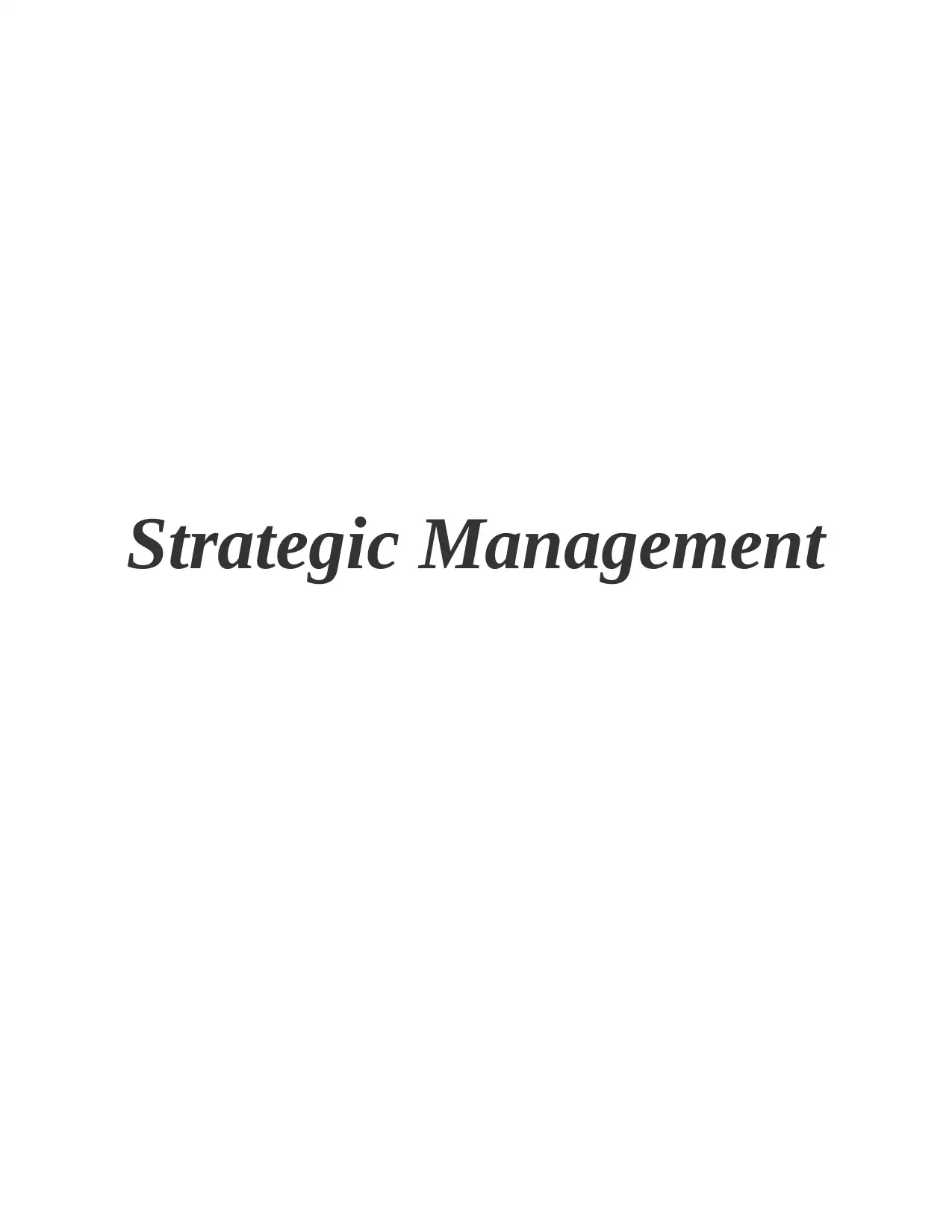
Strategic Management
Paraphrase This Document
Need a fresh take? Get an instant paraphrase of this document with our AI Paraphraser
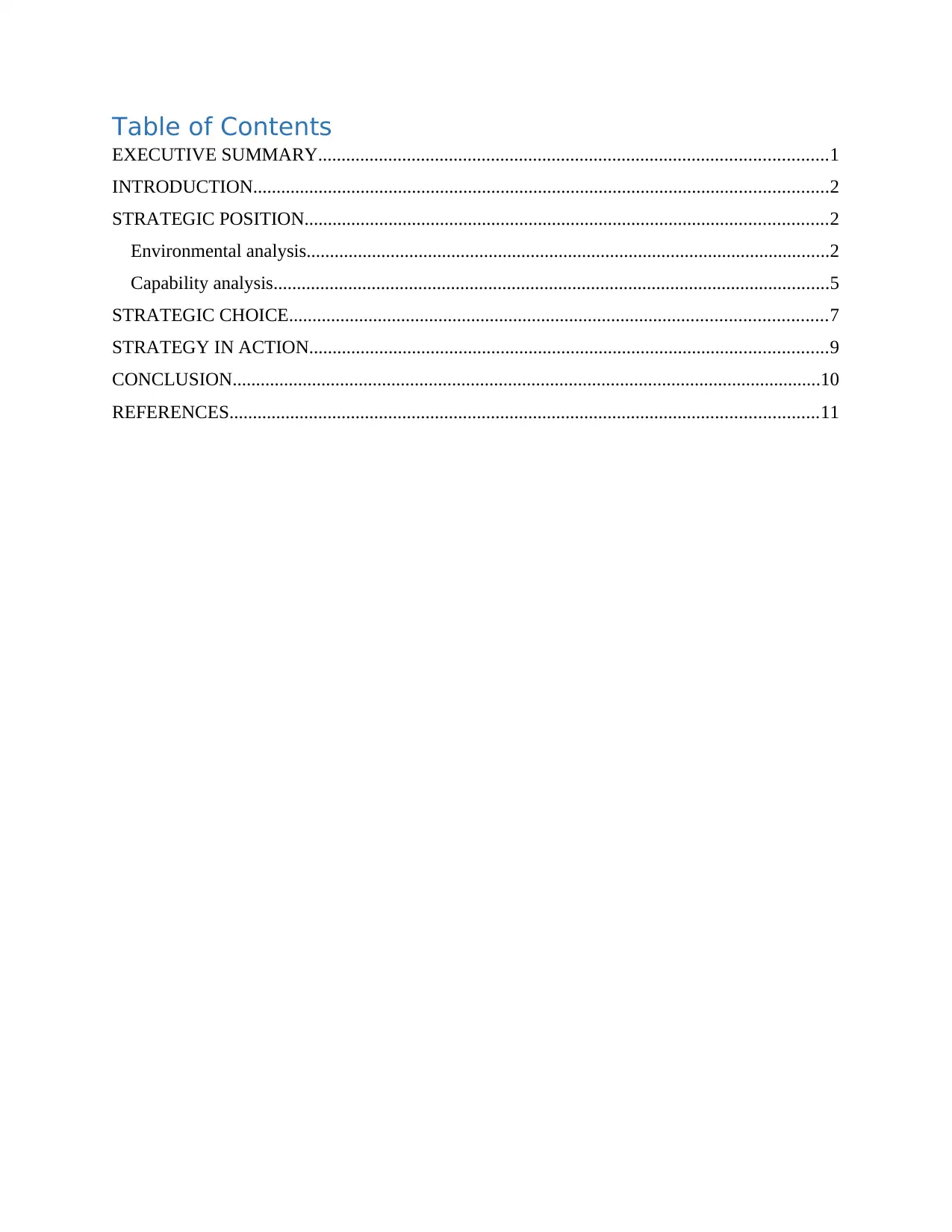
Table of Contents
EXECUTIVE SUMMARY.............................................................................................................1
INTRODUCTION...........................................................................................................................2
STRATEGIC POSITION................................................................................................................2
Environmental analysis................................................................................................................2
Capability analysis.......................................................................................................................5
STRATEGIC CHOICE...................................................................................................................7
STRATEGY IN ACTION...............................................................................................................9
CONCLUSION..............................................................................................................................10
REFERENCES..............................................................................................................................11
EXECUTIVE SUMMARY.............................................................................................................1
INTRODUCTION...........................................................................................................................2
STRATEGIC POSITION................................................................................................................2
Environmental analysis................................................................................................................2
Capability analysis.......................................................................................................................5
STRATEGIC CHOICE...................................................................................................................7
STRATEGY IN ACTION...............................................................................................................9
CONCLUSION..............................................................................................................................10
REFERENCES..............................................................................................................................11
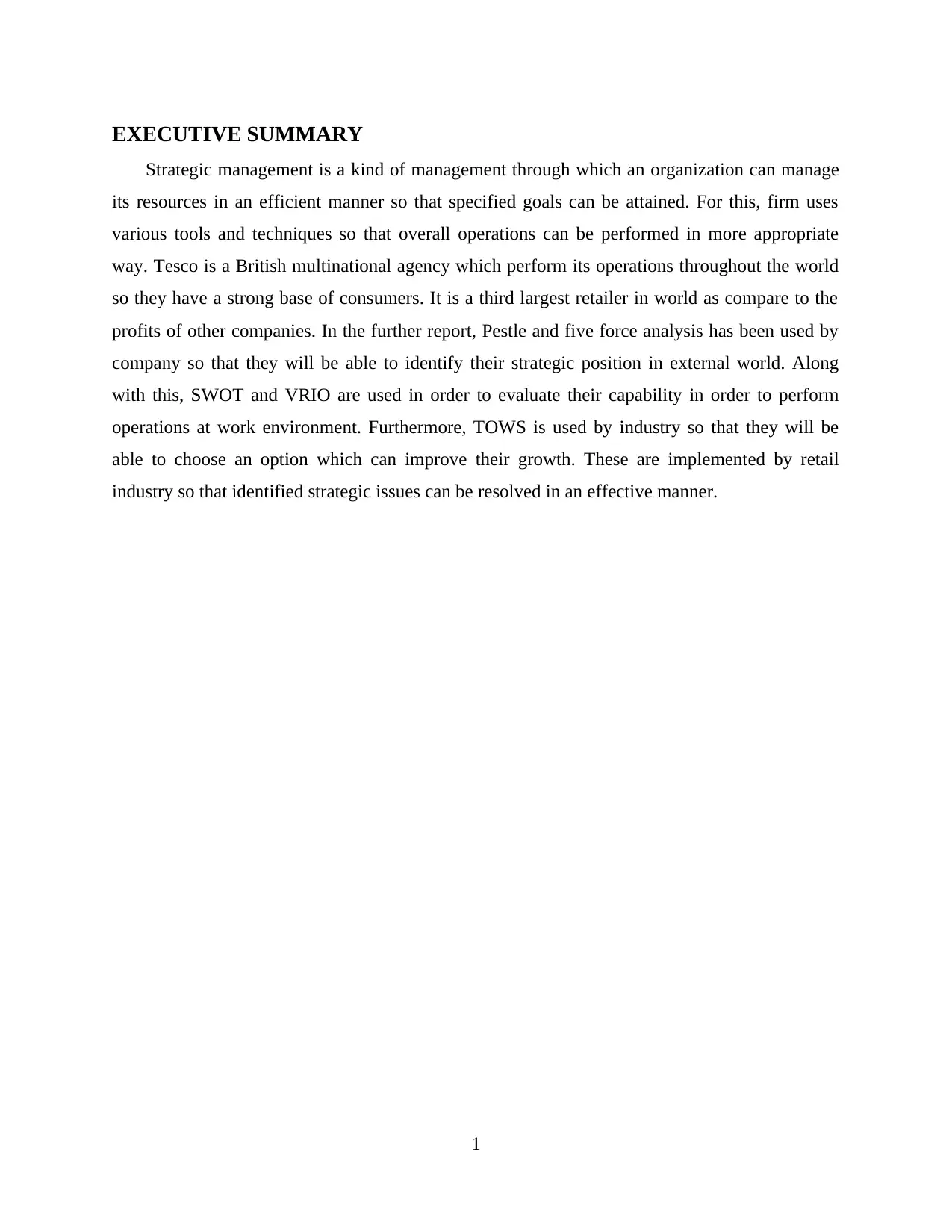
EXECUTIVE SUMMARY
Strategic management is a kind of management through which an organization can manage
its resources in an efficient manner so that specified goals can be attained. For this, firm uses
various tools and techniques so that overall operations can be performed in more appropriate
way. Tesco is a British multinational agency which perform its operations throughout the world
so they have a strong base of consumers. It is a third largest retailer in world as compare to the
profits of other companies. In the further report, Pestle and five force analysis has been used by
company so that they will be able to identify their strategic position in external world. Along
with this, SWOT and VRIO are used in order to evaluate their capability in order to perform
operations at work environment. Furthermore, TOWS is used by industry so that they will be
able to choose an option which can improve their growth. These are implemented by retail
industry so that identified strategic issues can be resolved in an effective manner.
1
Strategic management is a kind of management through which an organization can manage
its resources in an efficient manner so that specified goals can be attained. For this, firm uses
various tools and techniques so that overall operations can be performed in more appropriate
way. Tesco is a British multinational agency which perform its operations throughout the world
so they have a strong base of consumers. It is a third largest retailer in world as compare to the
profits of other companies. In the further report, Pestle and five force analysis has been used by
company so that they will be able to identify their strategic position in external world. Along
with this, SWOT and VRIO are used in order to evaluate their capability in order to perform
operations at work environment. Furthermore, TOWS is used by industry so that they will be
able to choose an option which can improve their growth. These are implemented by retail
industry so that identified strategic issues can be resolved in an effective manner.
1
⊘ This is a preview!⊘
Do you want full access?
Subscribe today to unlock all pages.

Trusted by 1+ million students worldwide
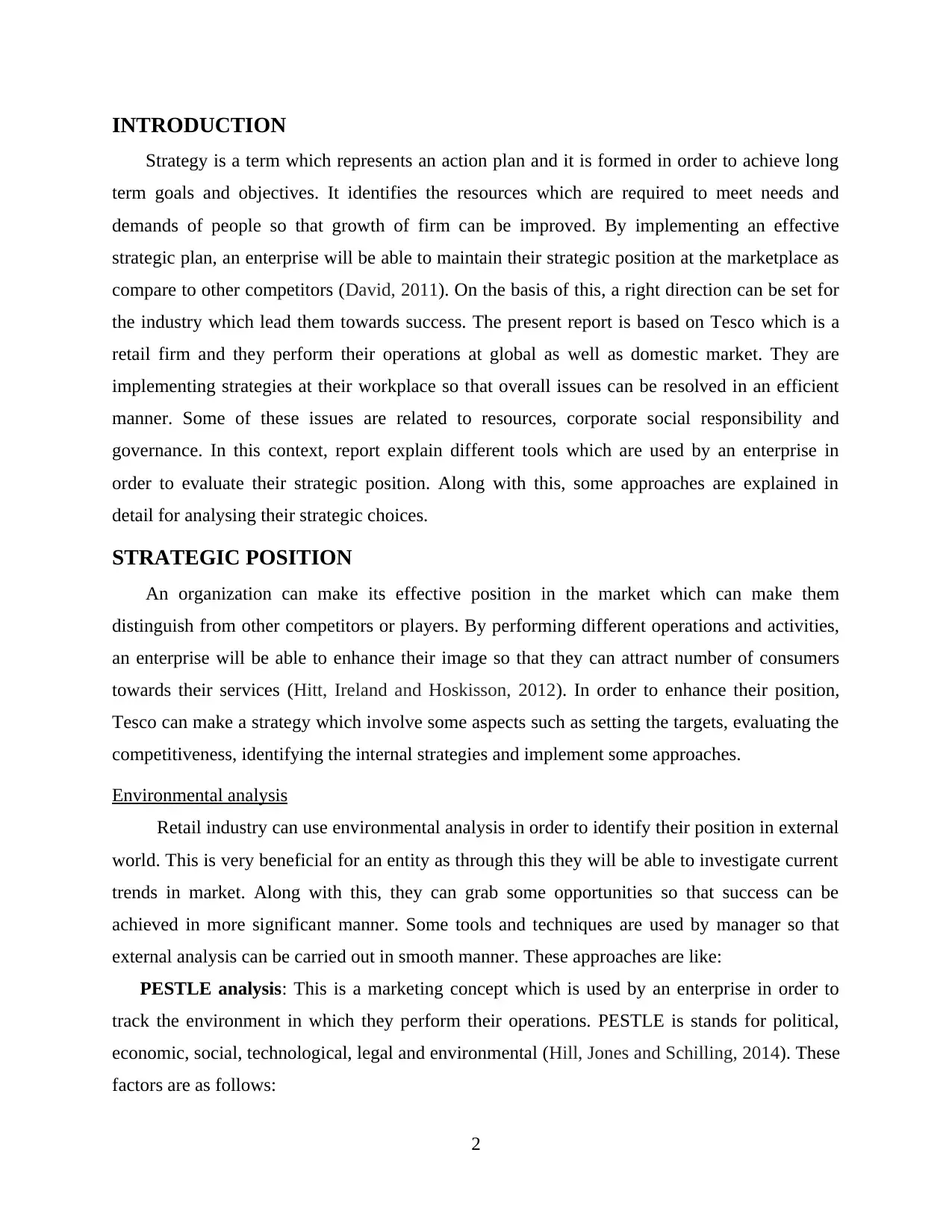
INTRODUCTION
Strategy is a term which represents an action plan and it is formed in order to achieve long
term goals and objectives. It identifies the resources which are required to meet needs and
demands of people so that growth of firm can be improved. By implementing an effective
strategic plan, an enterprise will be able to maintain their strategic position at the marketplace as
compare to other competitors (David, 2011). On the basis of this, a right direction can be set for
the industry which lead them towards success. The present report is based on Tesco which is a
retail firm and they perform their operations at global as well as domestic market. They are
implementing strategies at their workplace so that overall issues can be resolved in an efficient
manner. Some of these issues are related to resources, corporate social responsibility and
governance. In this context, report explain different tools which are used by an enterprise in
order to evaluate their strategic position. Along with this, some approaches are explained in
detail for analysing their strategic choices.
STRATEGIC POSITION
An organization can make its effective position in the market which can make them
distinguish from other competitors or players. By performing different operations and activities,
an enterprise will be able to enhance their image so that they can attract number of consumers
towards their services (Hitt, Ireland and Hoskisson, 2012). In order to enhance their position,
Tesco can make a strategy which involve some aspects such as setting the targets, evaluating the
competitiveness, identifying the internal strategies and implement some approaches.
Environmental analysis
Retail industry can use environmental analysis in order to identify their position in external
world. This is very beneficial for an entity as through this they will be able to investigate current
trends in market. Along with this, they can grab some opportunities so that success can be
achieved in more significant manner. Some tools and techniques are used by manager so that
external analysis can be carried out in smooth manner. These approaches are like:
PESTLE analysis: This is a marketing concept which is used by an enterprise in order to
track the environment in which they perform their operations. PESTLE is stands for political,
economic, social, technological, legal and environmental (Hill, Jones and Schilling, 2014). These
factors are as follows:
2
Strategy is a term which represents an action plan and it is formed in order to achieve long
term goals and objectives. It identifies the resources which are required to meet needs and
demands of people so that growth of firm can be improved. By implementing an effective
strategic plan, an enterprise will be able to maintain their strategic position at the marketplace as
compare to other competitors (David, 2011). On the basis of this, a right direction can be set for
the industry which lead them towards success. The present report is based on Tesco which is a
retail firm and they perform their operations at global as well as domestic market. They are
implementing strategies at their workplace so that overall issues can be resolved in an efficient
manner. Some of these issues are related to resources, corporate social responsibility and
governance. In this context, report explain different tools which are used by an enterprise in
order to evaluate their strategic position. Along with this, some approaches are explained in
detail for analysing their strategic choices.
STRATEGIC POSITION
An organization can make its effective position in the market which can make them
distinguish from other competitors or players. By performing different operations and activities,
an enterprise will be able to enhance their image so that they can attract number of consumers
towards their services (Hitt, Ireland and Hoskisson, 2012). In order to enhance their position,
Tesco can make a strategy which involve some aspects such as setting the targets, evaluating the
competitiveness, identifying the internal strategies and implement some approaches.
Environmental analysis
Retail industry can use environmental analysis in order to identify their position in external
world. This is very beneficial for an entity as through this they will be able to investigate current
trends in market. Along with this, they can grab some opportunities so that success can be
achieved in more significant manner. Some tools and techniques are used by manager so that
external analysis can be carried out in smooth manner. These approaches are like:
PESTLE analysis: This is a marketing concept which is used by an enterprise in order to
track the environment in which they perform their operations. PESTLE is stands for political,
economic, social, technological, legal and environmental (Hill, Jones and Schilling, 2014). These
factors are as follows:
2
Paraphrase This Document
Need a fresh take? Get an instant paraphrase of this document with our AI Paraphraser
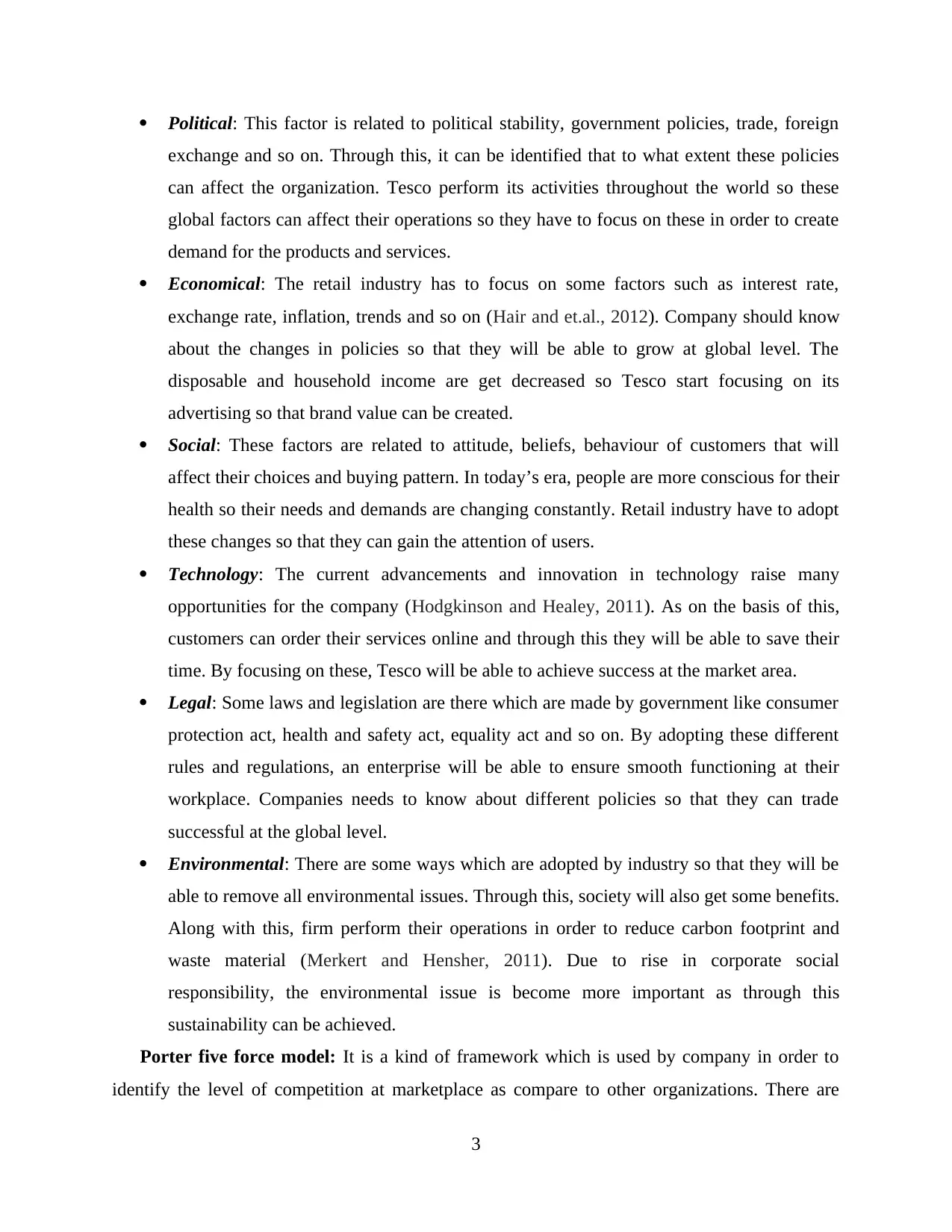
Political: This factor is related to political stability, government policies, trade, foreign
exchange and so on. Through this, it can be identified that to what extent these policies
can affect the organization. Tesco perform its activities throughout the world so these
global factors can affect their operations so they have to focus on these in order to create
demand for the products and services.
Economical: The retail industry has to focus on some factors such as interest rate,
exchange rate, inflation, trends and so on (Hair and et.al., 2012). Company should know
about the changes in policies so that they will be able to grow at global level. The
disposable and household income are get decreased so Tesco start focusing on its
advertising so that brand value can be created.
Social: These factors are related to attitude, beliefs, behaviour of customers that will
affect their choices and buying pattern. In today’s era, people are more conscious for their
health so their needs and demands are changing constantly. Retail industry have to adopt
these changes so that they can gain the attention of users.
Technology: The current advancements and innovation in technology raise many
opportunities for the company (Hodgkinson and Healey, 2011). As on the basis of this,
customers can order their services online and through this they will be able to save their
time. By focusing on these, Tesco will be able to achieve success at the market area.
Legal: Some laws and legislation are there which are made by government like consumer
protection act, health and safety act, equality act and so on. By adopting these different
rules and regulations, an enterprise will be able to ensure smooth functioning at their
workplace. Companies needs to know about different policies so that they can trade
successful at the global level.
Environmental: There are some ways which are adopted by industry so that they will be
able to remove all environmental issues. Through this, society will also get some benefits.
Along with this, firm perform their operations in order to reduce carbon footprint and
waste material (Merkert and Hensher, 2011). Due to rise in corporate social
responsibility, the environmental issue is become more important as through this
sustainability can be achieved.
Porter five force model: It is a kind of framework which is used by company in order to
identify the level of competition at marketplace as compare to other organizations. There are
3
exchange and so on. Through this, it can be identified that to what extent these policies
can affect the organization. Tesco perform its activities throughout the world so these
global factors can affect their operations so they have to focus on these in order to create
demand for the products and services.
Economical: The retail industry has to focus on some factors such as interest rate,
exchange rate, inflation, trends and so on (Hair and et.al., 2012). Company should know
about the changes in policies so that they will be able to grow at global level. The
disposable and household income are get decreased so Tesco start focusing on its
advertising so that brand value can be created.
Social: These factors are related to attitude, beliefs, behaviour of customers that will
affect their choices and buying pattern. In today’s era, people are more conscious for their
health so their needs and demands are changing constantly. Retail industry have to adopt
these changes so that they can gain the attention of users.
Technology: The current advancements and innovation in technology raise many
opportunities for the company (Hodgkinson and Healey, 2011). As on the basis of this,
customers can order their services online and through this they will be able to save their
time. By focusing on these, Tesco will be able to achieve success at the market area.
Legal: Some laws and legislation are there which are made by government like consumer
protection act, health and safety act, equality act and so on. By adopting these different
rules and regulations, an enterprise will be able to ensure smooth functioning at their
workplace. Companies needs to know about different policies so that they can trade
successful at the global level.
Environmental: There are some ways which are adopted by industry so that they will be
able to remove all environmental issues. Through this, society will also get some benefits.
Along with this, firm perform their operations in order to reduce carbon footprint and
waste material (Merkert and Hensher, 2011). Due to rise in corporate social
responsibility, the environmental issue is become more important as through this
sustainability can be achieved.
Porter five force model: It is a kind of framework which is used by company in order to
identify the level of competition at marketplace as compare to other organizations. There are
3
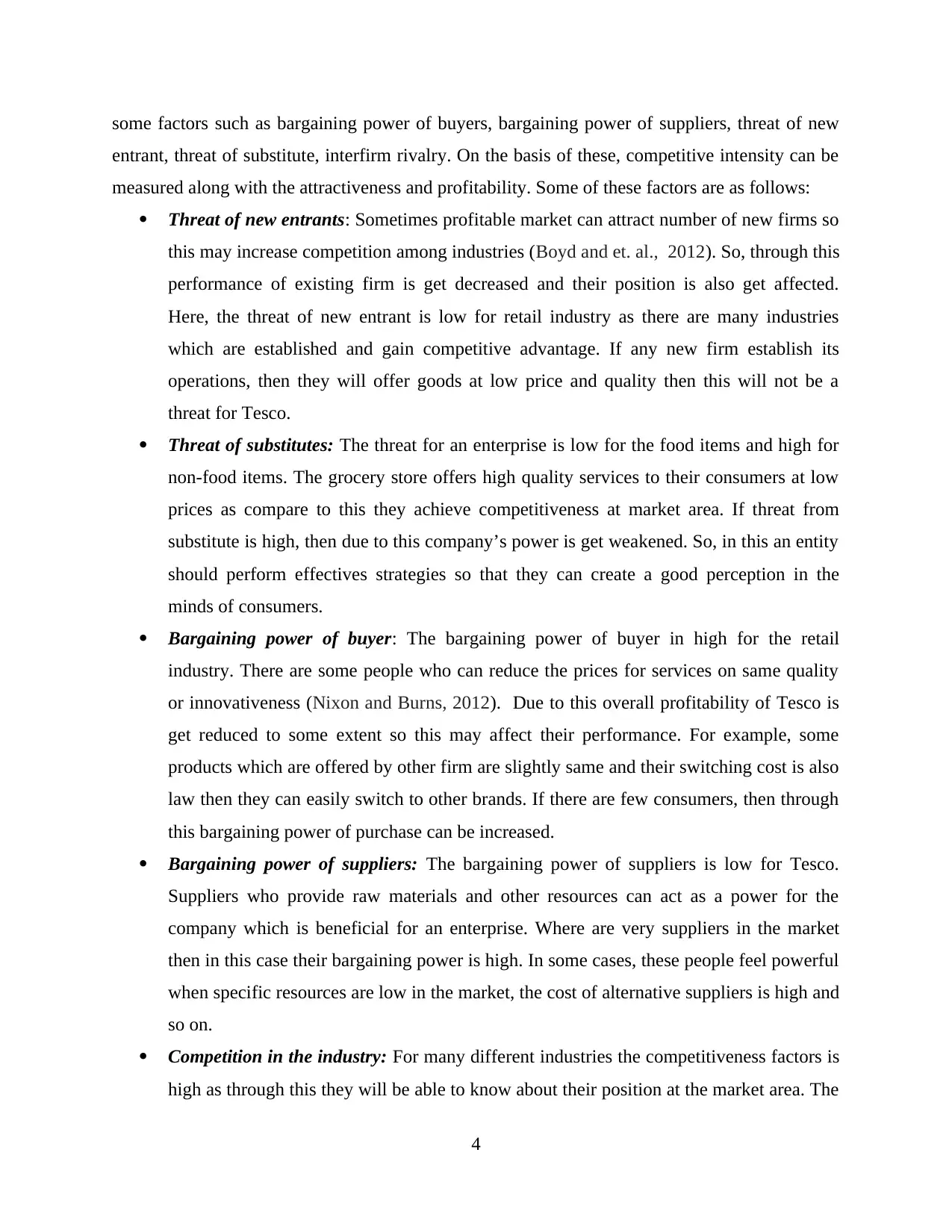
some factors such as bargaining power of buyers, bargaining power of suppliers, threat of new
entrant, threat of substitute, interfirm rivalry. On the basis of these, competitive intensity can be
measured along with the attractiveness and profitability. Some of these factors are as follows:
Threat of new entrants: Sometimes profitable market can attract number of new firms so
this may increase competition among industries (Boyd and et. al., 2012). So, through this
performance of existing firm is get decreased and their position is also get affected.
Here, the threat of new entrant is low for retail industry as there are many industries
which are established and gain competitive advantage. If any new firm establish its
operations, then they will offer goods at low price and quality then this will not be a
threat for Tesco.
Threat of substitutes: The threat for an enterprise is low for the food items and high for
non-food items. The grocery store offers high quality services to their consumers at low
prices as compare to this they achieve competitiveness at market area. If threat from
substitute is high, then due to this company’s power is get weakened. So, in this an entity
should perform effectives strategies so that they can create a good perception in the
minds of consumers.
Bargaining power of buyer: The bargaining power of buyer in high for the retail
industry. There are some people who can reduce the prices for services on same quality
or innovativeness (Nixon and Burns, 2012). Due to this overall profitability of Tesco is
get reduced to some extent so this may affect their performance. For example, some
products which are offered by other firm are slightly same and their switching cost is also
law then they can easily switch to other brands. If there are few consumers, then through
this bargaining power of purchase can be increased.
Bargaining power of suppliers: The bargaining power of suppliers is low for Tesco.
Suppliers who provide raw materials and other resources can act as a power for the
company which is beneficial for an enterprise. Where are very suppliers in the market
then in this case their bargaining power is high. In some cases, these people feel powerful
when specific resources are low in the market, the cost of alternative suppliers is high and
so on.
Competition in the industry: For many different industries the competitiveness factors is
high as through this they will be able to know about their position at the market area. The
4
entrant, threat of substitute, interfirm rivalry. On the basis of these, competitive intensity can be
measured along with the attractiveness and profitability. Some of these factors are as follows:
Threat of new entrants: Sometimes profitable market can attract number of new firms so
this may increase competition among industries (Boyd and et. al., 2012). So, through this
performance of existing firm is get decreased and their position is also get affected.
Here, the threat of new entrant is low for retail industry as there are many industries
which are established and gain competitive advantage. If any new firm establish its
operations, then they will offer goods at low price and quality then this will not be a
threat for Tesco.
Threat of substitutes: The threat for an enterprise is low for the food items and high for
non-food items. The grocery store offers high quality services to their consumers at low
prices as compare to this they achieve competitiveness at market area. If threat from
substitute is high, then due to this company’s power is get weakened. So, in this an entity
should perform effectives strategies so that they can create a good perception in the
minds of consumers.
Bargaining power of buyer: The bargaining power of buyer in high for the retail
industry. There are some people who can reduce the prices for services on same quality
or innovativeness (Nixon and Burns, 2012). Due to this overall profitability of Tesco is
get reduced to some extent so this may affect their performance. For example, some
products which are offered by other firm are slightly same and their switching cost is also
law then they can easily switch to other brands. If there are few consumers, then through
this bargaining power of purchase can be increased.
Bargaining power of suppliers: The bargaining power of suppliers is low for Tesco.
Suppliers who provide raw materials and other resources can act as a power for the
company which is beneficial for an enterprise. Where are very suppliers in the market
then in this case their bargaining power is high. In some cases, these people feel powerful
when specific resources are low in the market, the cost of alternative suppliers is high and
so on.
Competition in the industry: For many different industries the competitiveness factors is
high as through this they will be able to know about their position at the market area. The
4
⊘ This is a preview!⊘
Do you want full access?
Subscribe today to unlock all pages.

Trusted by 1+ million students worldwide
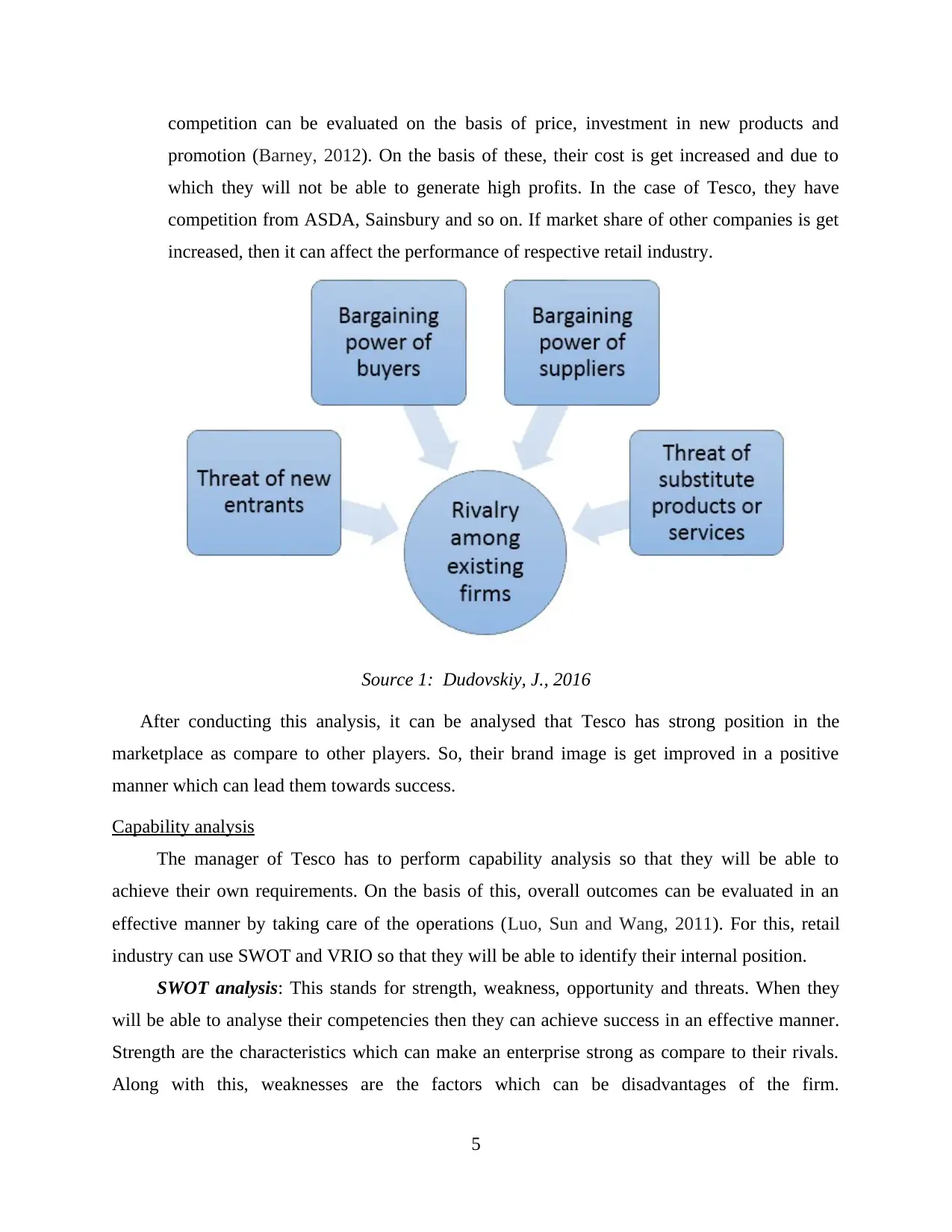
competition can be evaluated on the basis of price, investment in new products and
promotion (Barney, 2012). On the basis of these, their cost is get increased and due to
which they will not be able to generate high profits. In the case of Tesco, they have
competition from ASDA, Sainsbury and so on. If market share of other companies is get
increased, then it can affect the performance of respective retail industry.
Source 1: Dudovskiy, J., 2016
After conducting this analysis, it can be analysed that Tesco has strong position in the
marketplace as compare to other players. So, their brand image is get improved in a positive
manner which can lead them towards success.
Capability analysis
The manager of Tesco has to perform capability analysis so that they will be able to
achieve their own requirements. On the basis of this, overall outcomes can be evaluated in an
effective manner by taking care of the operations (Luo, Sun and Wang, 2011). For this, retail
industry can use SWOT and VRIO so that they will be able to identify their internal position.
SWOT analysis: This stands for strength, weakness, opportunity and threats. When they
will be able to analyse their competencies then they can achieve success in an effective manner.
Strength are the characteristics which can make an enterprise strong as compare to their rivals.
Along with this, weaknesses are the factors which can be disadvantages of the firm.
5
promotion (Barney, 2012). On the basis of these, their cost is get increased and due to
which they will not be able to generate high profits. In the case of Tesco, they have
competition from ASDA, Sainsbury and so on. If market share of other companies is get
increased, then it can affect the performance of respective retail industry.
Source 1: Dudovskiy, J., 2016
After conducting this analysis, it can be analysed that Tesco has strong position in the
marketplace as compare to other players. So, their brand image is get improved in a positive
manner which can lead them towards success.
Capability analysis
The manager of Tesco has to perform capability analysis so that they will be able to
achieve their own requirements. On the basis of this, overall outcomes can be evaluated in an
effective manner by taking care of the operations (Luo, Sun and Wang, 2011). For this, retail
industry can use SWOT and VRIO so that they will be able to identify their internal position.
SWOT analysis: This stands for strength, weakness, opportunity and threats. When they
will be able to analyse their competencies then they can achieve success in an effective manner.
Strength are the characteristics which can make an enterprise strong as compare to their rivals.
Along with this, weaknesses are the factors which can be disadvantages of the firm.
5
Paraphrase This Document
Need a fresh take? Get an instant paraphrase of this document with our AI Paraphraser
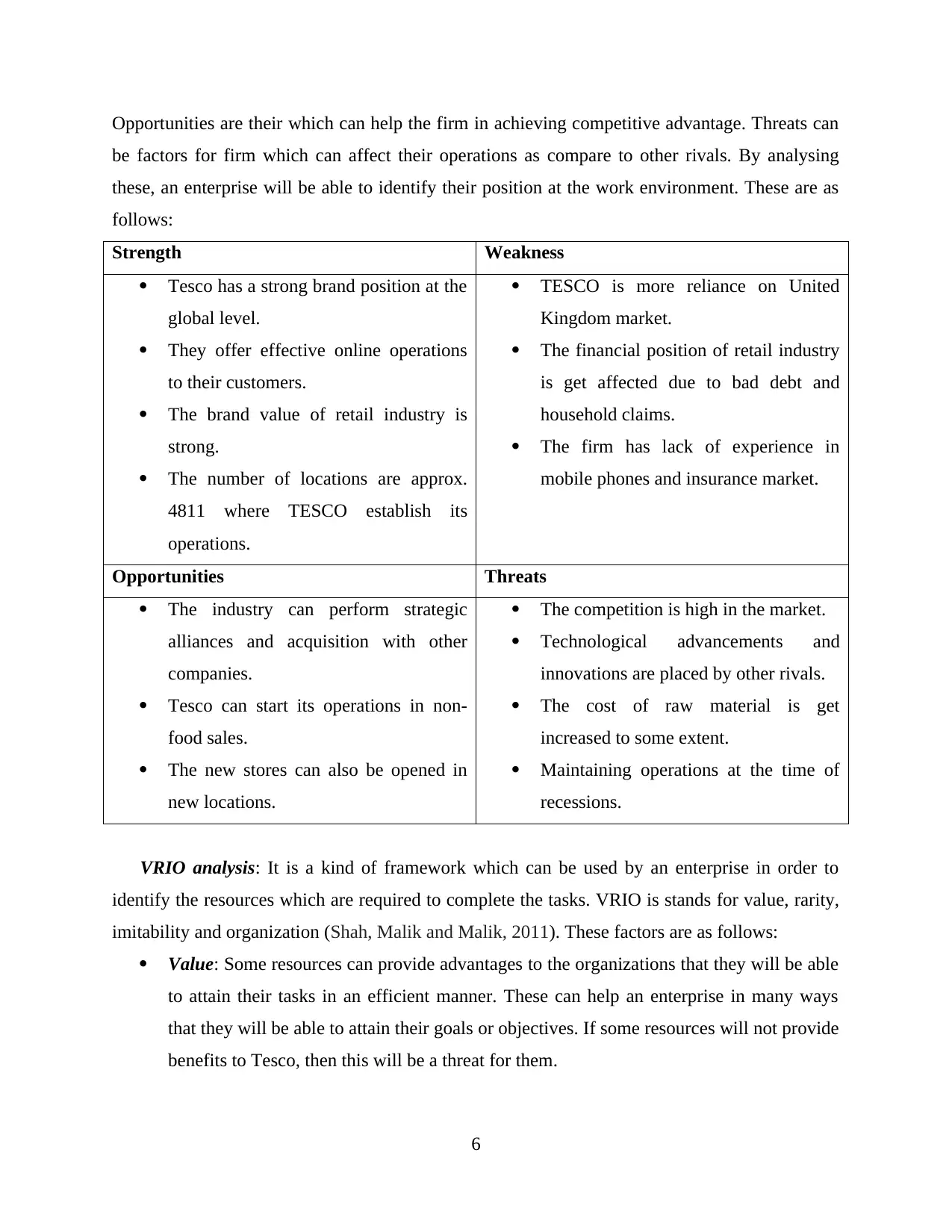
Opportunities are their which can help the firm in achieving competitive advantage. Threats can
be factors for firm which can affect their operations as compare to other rivals. By analysing
these, an enterprise will be able to identify their position at the work environment. These are as
follows:
Strength Weakness
Tesco has a strong brand position at the
global level.
They offer effective online operations
to their customers.
The brand value of retail industry is
strong.
The number of locations are approx.
4811 where TESCO establish its
operations.
TESCO is more reliance on United
Kingdom market.
The financial position of retail industry
is get affected due to bad debt and
household claims.
The firm has lack of experience in
mobile phones and insurance market.
Opportunities Threats
The industry can perform strategic
alliances and acquisition with other
companies.
Tesco can start its operations in non-
food sales.
The new stores can also be opened in
new locations.
The competition is high in the market.
Technological advancements and
innovations are placed by other rivals.
The cost of raw material is get
increased to some extent.
Maintaining operations at the time of
recessions.
VRIO analysis: It is a kind of framework which can be used by an enterprise in order to
identify the resources which are required to complete the tasks. VRIO is stands for value, rarity,
imitability and organization (Shah, Malik and Malik, 2011). These factors are as follows:
Value: Some resources can provide advantages to the organizations that they will be able
to attain their tasks in an efficient manner. These can help an enterprise in many ways
that they will be able to attain their goals or objectives. If some resources will not provide
benefits to Tesco, then this will be a threat for them.
6
be factors for firm which can affect their operations as compare to other rivals. By analysing
these, an enterprise will be able to identify their position at the work environment. These are as
follows:
Strength Weakness
Tesco has a strong brand position at the
global level.
They offer effective online operations
to their customers.
The brand value of retail industry is
strong.
The number of locations are approx.
4811 where TESCO establish its
operations.
TESCO is more reliance on United
Kingdom market.
The financial position of retail industry
is get affected due to bad debt and
household claims.
The firm has lack of experience in
mobile phones and insurance market.
Opportunities Threats
The industry can perform strategic
alliances and acquisition with other
companies.
Tesco can start its operations in non-
food sales.
The new stores can also be opened in
new locations.
The competition is high in the market.
Technological advancements and
innovations are placed by other rivals.
The cost of raw material is get
increased to some extent.
Maintaining operations at the time of
recessions.
VRIO analysis: It is a kind of framework which can be used by an enterprise in order to
identify the resources which are required to complete the tasks. VRIO is stands for value, rarity,
imitability and organization (Shah, Malik and Malik, 2011). These factors are as follows:
Value: Some resources can provide advantages to the organizations that they will be able
to attain their tasks in an efficient manner. These can help an enterprise in many ways
that they will be able to attain their goals or objectives. If some resources will not provide
benefits to Tesco, then this will be a threat for them.
6
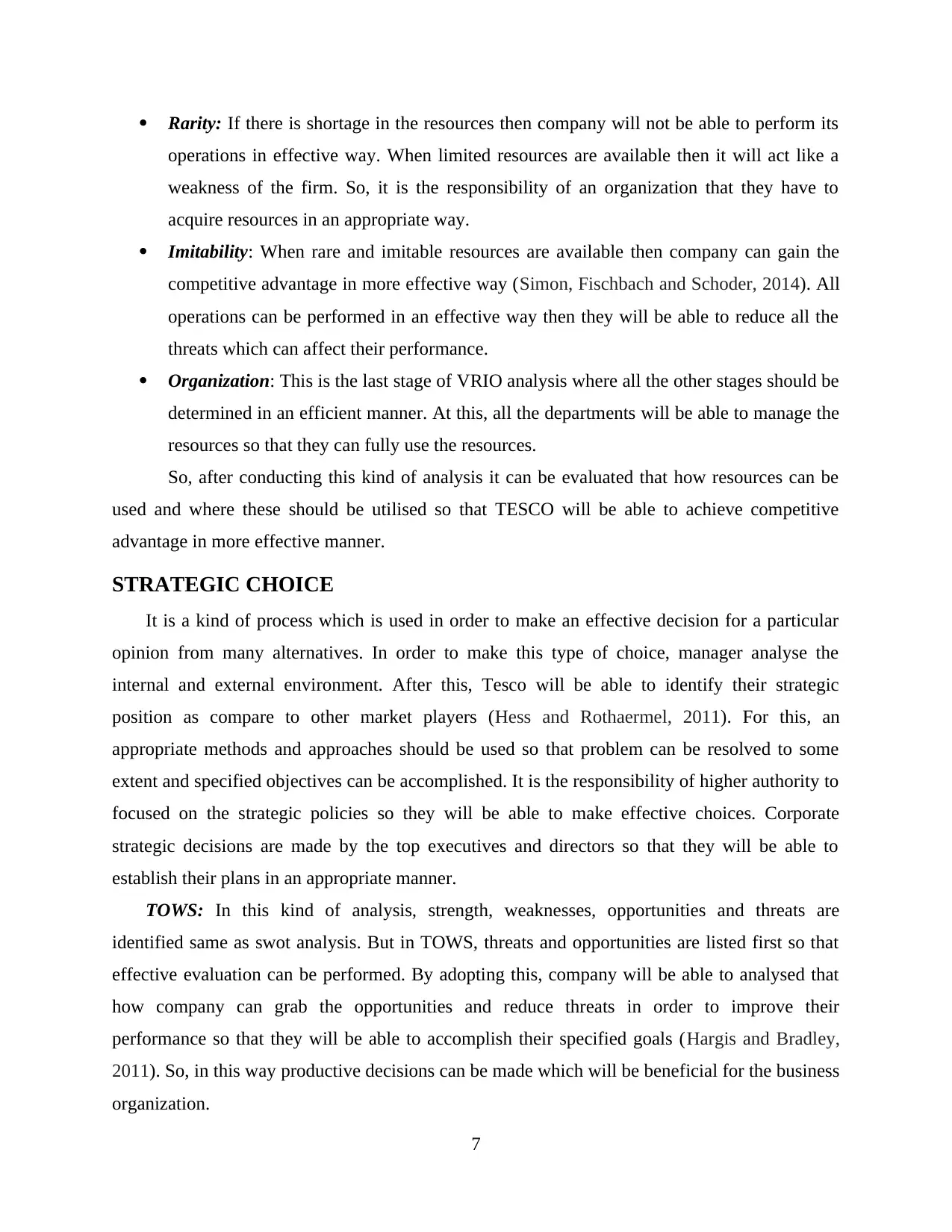
Rarity: If there is shortage in the resources then company will not be able to perform its
operations in effective way. When limited resources are available then it will act like a
weakness of the firm. So, it is the responsibility of an organization that they have to
acquire resources in an appropriate way.
Imitability: When rare and imitable resources are available then company can gain the
competitive advantage in more effective way (Simon, Fischbach and Schoder, 2014). All
operations can be performed in an effective way then they will be able to reduce all the
threats which can affect their performance.
Organization: This is the last stage of VRIO analysis where all the other stages should be
determined in an efficient manner. At this, all the departments will be able to manage the
resources so that they can fully use the resources.
So, after conducting this kind of analysis it can be evaluated that how resources can be
used and where these should be utilised so that TESCO will be able to achieve competitive
advantage in more effective manner.
STRATEGIC CHOICE
It is a kind of process which is used in order to make an effective decision for a particular
opinion from many alternatives. In order to make this type of choice, manager analyse the
internal and external environment. After this, Tesco will be able to identify their strategic
position as compare to other market players (Hess and Rothaermel, 2011). For this, an
appropriate methods and approaches should be used so that problem can be resolved to some
extent and specified objectives can be accomplished. It is the responsibility of higher authority to
focused on the strategic policies so they will be able to make effective choices. Corporate
strategic decisions are made by the top executives and directors so that they will be able to
establish their plans in an appropriate manner.
TOWS: In this kind of analysis, strength, weaknesses, opportunities and threats are
identified same as swot analysis. But in TOWS, threats and opportunities are listed first so that
effective evaluation can be performed. By adopting this, company will be able to analysed that
how company can grab the opportunities and reduce threats in order to improve their
performance so that they will be able to accomplish their specified goals (Hargis and Bradley,
2011). So, in this way productive decisions can be made which will be beneficial for the business
organization.
7
operations in effective way. When limited resources are available then it will act like a
weakness of the firm. So, it is the responsibility of an organization that they have to
acquire resources in an appropriate way.
Imitability: When rare and imitable resources are available then company can gain the
competitive advantage in more effective way (Simon, Fischbach and Schoder, 2014). All
operations can be performed in an effective way then they will be able to reduce all the
threats which can affect their performance.
Organization: This is the last stage of VRIO analysis where all the other stages should be
determined in an efficient manner. At this, all the departments will be able to manage the
resources so that they can fully use the resources.
So, after conducting this kind of analysis it can be evaluated that how resources can be
used and where these should be utilised so that TESCO will be able to achieve competitive
advantage in more effective manner.
STRATEGIC CHOICE
It is a kind of process which is used in order to make an effective decision for a particular
opinion from many alternatives. In order to make this type of choice, manager analyse the
internal and external environment. After this, Tesco will be able to identify their strategic
position as compare to other market players (Hess and Rothaermel, 2011). For this, an
appropriate methods and approaches should be used so that problem can be resolved to some
extent and specified objectives can be accomplished. It is the responsibility of higher authority to
focused on the strategic policies so they will be able to make effective choices. Corporate
strategic decisions are made by the top executives and directors so that they will be able to
establish their plans in an appropriate manner.
TOWS: In this kind of analysis, strength, weaknesses, opportunities and threats are
identified same as swot analysis. But in TOWS, threats and opportunities are listed first so that
effective evaluation can be performed. By adopting this, company will be able to analysed that
how company can grab the opportunities and reduce threats in order to improve their
performance so that they will be able to accomplish their specified goals (Hargis and Bradley,
2011). So, in this way productive decisions can be made which will be beneficial for the business
organization.
7
⊘ This is a preview!⊘
Do you want full access?
Subscribe today to unlock all pages.

Trusted by 1+ million students worldwide
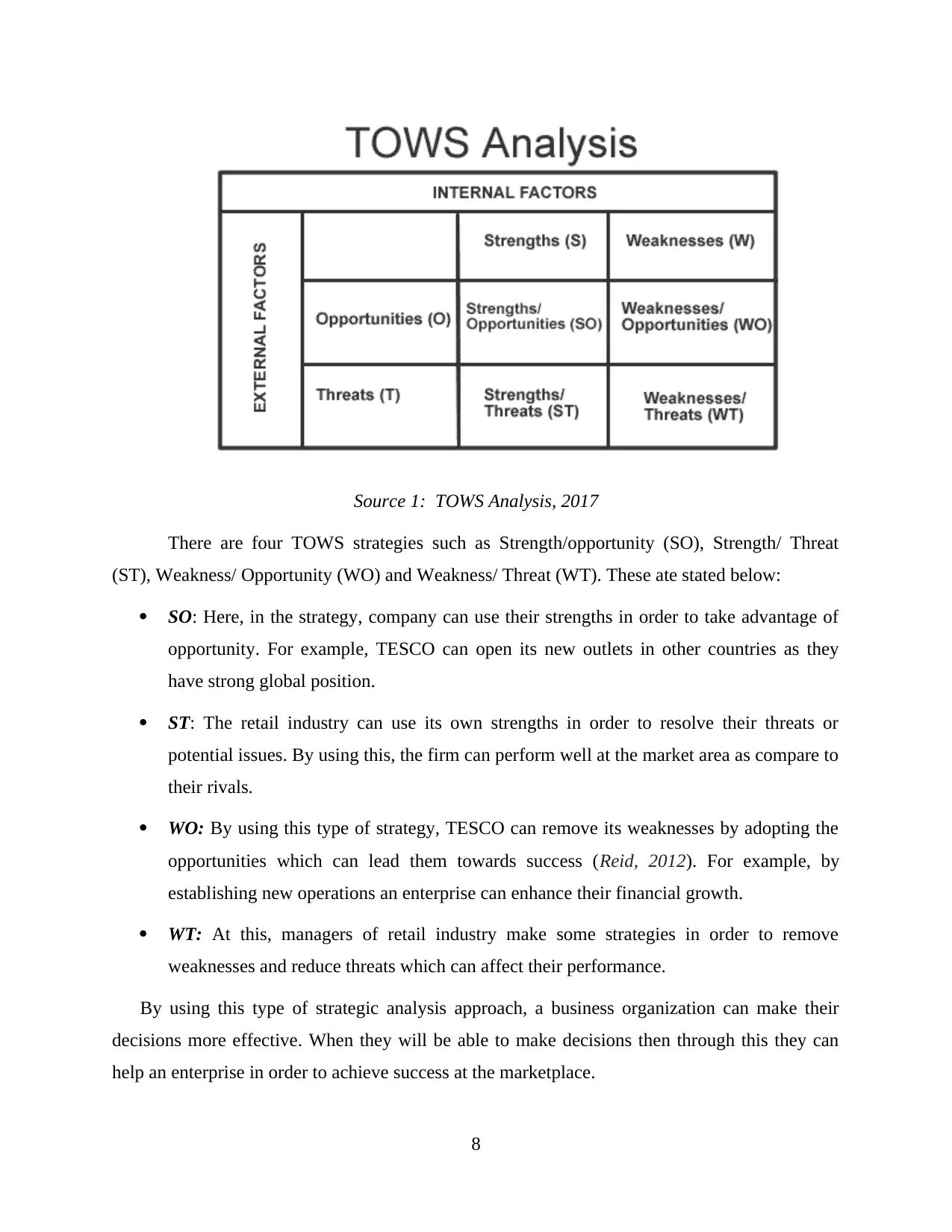
Source 1: TOWS Analysis, 2017
There are four TOWS strategies such as Strength/opportunity (SO), Strength/ Threat
(ST), Weakness/ Opportunity (WO) and Weakness/ Threat (WT). These ate stated below:
SO: Here, in the strategy, company can use their strengths in order to take advantage of
opportunity. For example, TESCO can open its new outlets in other countries as they
have strong global position.
ST: The retail industry can use its own strengths in order to resolve their threats or
potential issues. By using this, the firm can perform well at the market area as compare to
their rivals.
WO: By using this type of strategy, TESCO can remove its weaknesses by adopting the
opportunities which can lead them towards success (Reid, 2012). For example, by
establishing new operations an enterprise can enhance their financial growth.
WT: At this, managers of retail industry make some strategies in order to remove
weaknesses and reduce threats which can affect their performance.
By using this type of strategic analysis approach, a business organization can make their
decisions more effective. When they will be able to make decisions then through this they can
help an enterprise in order to achieve success at the marketplace.
8
There are four TOWS strategies such as Strength/opportunity (SO), Strength/ Threat
(ST), Weakness/ Opportunity (WO) and Weakness/ Threat (WT). These ate stated below:
SO: Here, in the strategy, company can use their strengths in order to take advantage of
opportunity. For example, TESCO can open its new outlets in other countries as they
have strong global position.
ST: The retail industry can use its own strengths in order to resolve their threats or
potential issues. By using this, the firm can perform well at the market area as compare to
their rivals.
WO: By using this type of strategy, TESCO can remove its weaknesses by adopting the
opportunities which can lead them towards success (Reid, 2012). For example, by
establishing new operations an enterprise can enhance their financial growth.
WT: At this, managers of retail industry make some strategies in order to remove
weaknesses and reduce threats which can affect their performance.
By using this type of strategic analysis approach, a business organization can make their
decisions more effective. When they will be able to make decisions then through this they can
help an enterprise in order to achieve success at the marketplace.
8
Paraphrase This Document
Need a fresh take? Get an instant paraphrase of this document with our AI Paraphraser
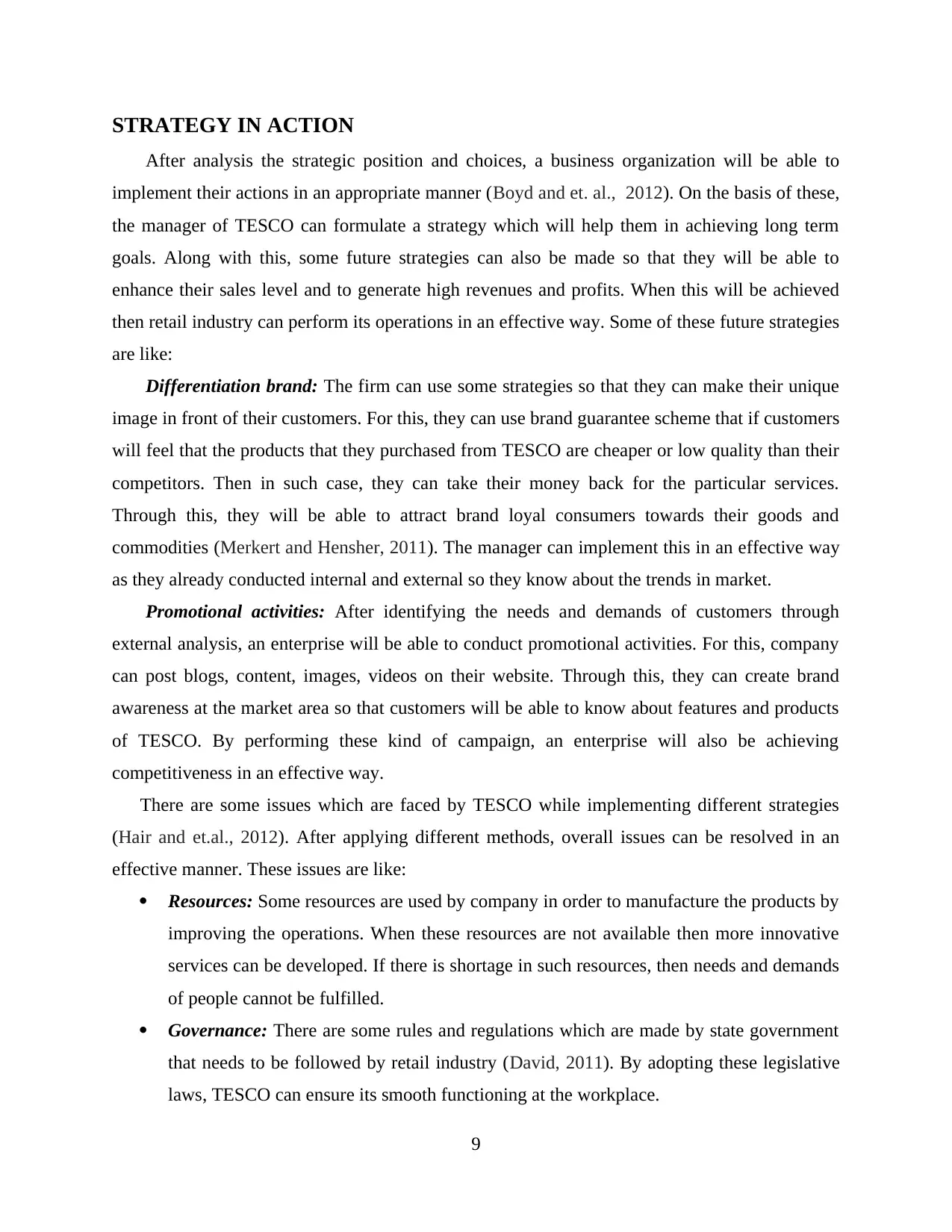
STRATEGY IN ACTION
After analysis the strategic position and choices, a business organization will be able to
implement their actions in an appropriate manner (Boyd and et. al., 2012). On the basis of these,
the manager of TESCO can formulate a strategy which will help them in achieving long term
goals. Along with this, some future strategies can also be made so that they will be able to
enhance their sales level and to generate high revenues and profits. When this will be achieved
then retail industry can perform its operations in an effective way. Some of these future strategies
are like:
Differentiation brand: The firm can use some strategies so that they can make their unique
image in front of their customers. For this, they can use brand guarantee scheme that if customers
will feel that the products that they purchased from TESCO are cheaper or low quality than their
competitors. Then in such case, they can take their money back for the particular services.
Through this, they will be able to attract brand loyal consumers towards their goods and
commodities (Merkert and Hensher, 2011). The manager can implement this in an effective way
as they already conducted internal and external so they know about the trends in market.
Promotional activities: After identifying the needs and demands of customers through
external analysis, an enterprise will be able to conduct promotional activities. For this, company
can post blogs, content, images, videos on their website. Through this, they can create brand
awareness at the market area so that customers will be able to know about features and products
of TESCO. By performing these kind of campaign, an enterprise will also be achieving
competitiveness in an effective way.
There are some issues which are faced by TESCO while implementing different strategies
(Hair and et.al., 2012). After applying different methods, overall issues can be resolved in an
effective manner. These issues are like:
Resources: Some resources are used by company in order to manufacture the products by
improving the operations. When these resources are not available then more innovative
services can be developed. If there is shortage in such resources, then needs and demands
of people cannot be fulfilled.
Governance: There are some rules and regulations which are made by state government
that needs to be followed by retail industry (David, 2011). By adopting these legislative
laws, TESCO can ensure its smooth functioning at the workplace.
9
After analysis the strategic position and choices, a business organization will be able to
implement their actions in an appropriate manner (Boyd and et. al., 2012). On the basis of these,
the manager of TESCO can formulate a strategy which will help them in achieving long term
goals. Along with this, some future strategies can also be made so that they will be able to
enhance their sales level and to generate high revenues and profits. When this will be achieved
then retail industry can perform its operations in an effective way. Some of these future strategies
are like:
Differentiation brand: The firm can use some strategies so that they can make their unique
image in front of their customers. For this, they can use brand guarantee scheme that if customers
will feel that the products that they purchased from TESCO are cheaper or low quality than their
competitors. Then in such case, they can take their money back for the particular services.
Through this, they will be able to attract brand loyal consumers towards their goods and
commodities (Merkert and Hensher, 2011). The manager can implement this in an effective way
as they already conducted internal and external so they know about the trends in market.
Promotional activities: After identifying the needs and demands of customers through
external analysis, an enterprise will be able to conduct promotional activities. For this, company
can post blogs, content, images, videos on their website. Through this, they can create brand
awareness at the market area so that customers will be able to know about features and products
of TESCO. By performing these kind of campaign, an enterprise will also be achieving
competitiveness in an effective way.
There are some issues which are faced by TESCO while implementing different strategies
(Hair and et.al., 2012). After applying different methods, overall issues can be resolved in an
effective manner. These issues are like:
Resources: Some resources are used by company in order to manufacture the products by
improving the operations. When these resources are not available then more innovative
services can be developed. If there is shortage in such resources, then needs and demands
of people cannot be fulfilled.
Governance: There are some rules and regulations which are made by state government
that needs to be followed by retail industry (David, 2011). By adopting these legislative
laws, TESCO can ensure its smooth functioning at the workplace.
9
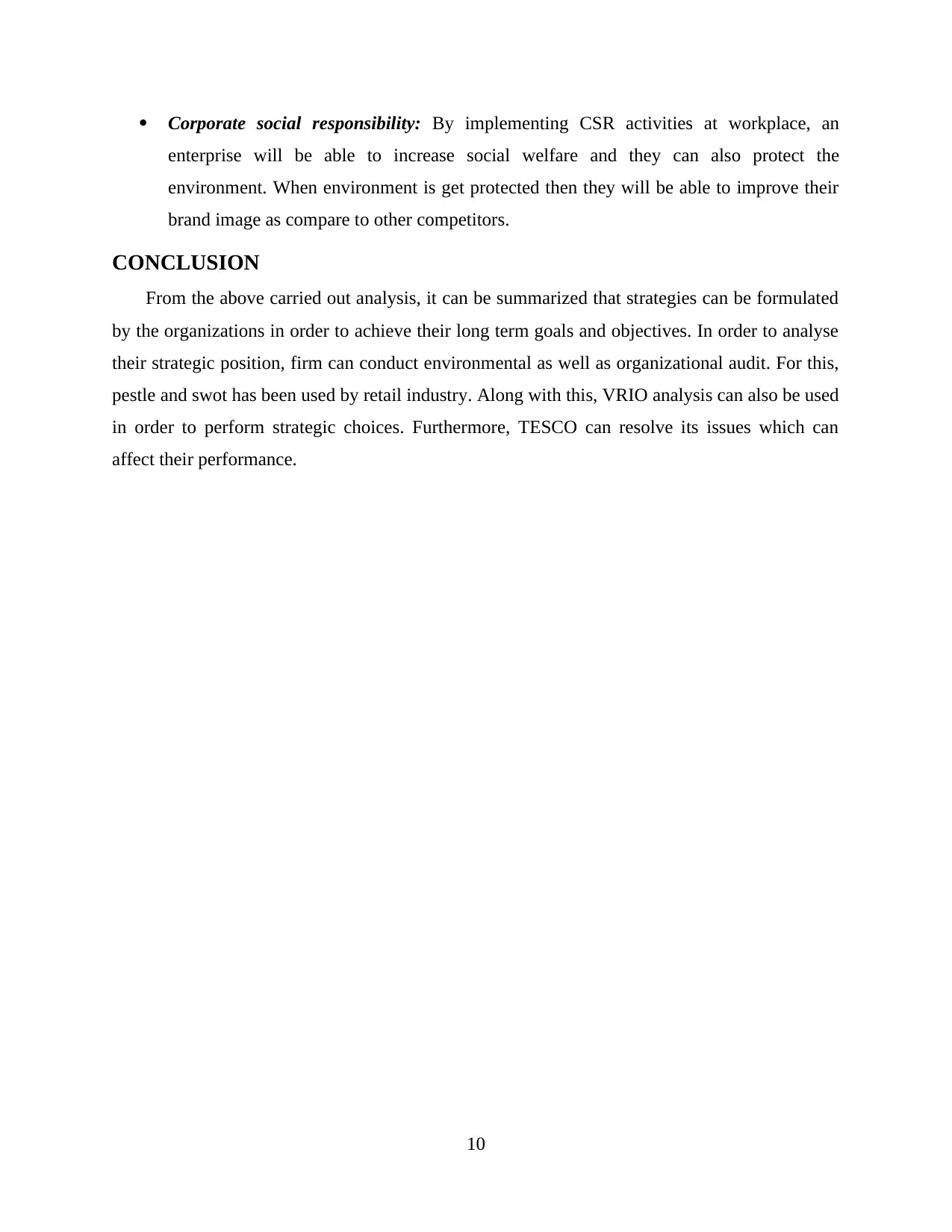
Corporate social responsibility: By implementing CSR activities at workplace, an
enterprise will be able to increase social welfare and they can also protect the
environment. When environment is get protected then they will be able to improve their
brand image as compare to other competitors.
CONCLUSION
From the above carried out analysis, it can be summarized that strategies can be formulated
by the organizations in order to achieve their long term goals and objectives. In order to analyse
their strategic position, firm can conduct environmental as well as organizational audit. For this,
pestle and swot has been used by retail industry. Along with this, VRIO analysis can also be used
in order to perform strategic choices. Furthermore, TESCO can resolve its issues which can
affect their performance.
10
enterprise will be able to increase social welfare and they can also protect the
environment. When environment is get protected then they will be able to improve their
brand image as compare to other competitors.
CONCLUSION
From the above carried out analysis, it can be summarized that strategies can be formulated
by the organizations in order to achieve their long term goals and objectives. In order to analyse
their strategic position, firm can conduct environmental as well as organizational audit. For this,
pestle and swot has been used by retail industry. Along with this, VRIO analysis can also be used
in order to perform strategic choices. Furthermore, TESCO can resolve its issues which can
affect their performance.
10
⊘ This is a preview!⊘
Do you want full access?
Subscribe today to unlock all pages.

Trusted by 1+ million students worldwide
1 out of 14
Related Documents
Your All-in-One AI-Powered Toolkit for Academic Success.
+13062052269
info@desklib.com
Available 24*7 on WhatsApp / Email
![[object Object]](/_next/static/media/star-bottom.7253800d.svg)
Unlock your academic potential
Copyright © 2020–2025 A2Z Services. All Rights Reserved. Developed and managed by ZUCOL.




